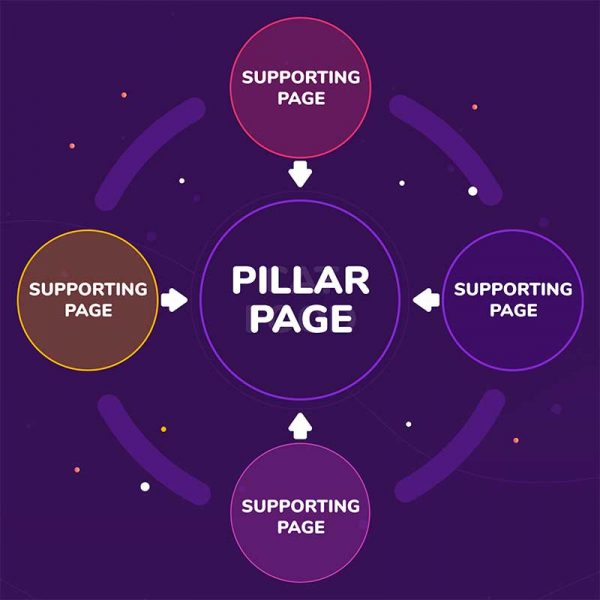As the year’s third quarter nears, you’re in a great position to consider what you need to change to meet your most aggressive year-end goals. If you need some new strategies to turn things around, this roundup may help.
First, you’ll pick up new skills from the guides. You’ll learn how to use topic clusters to master content marketing, what local justifications are (and why they matter), and how “jump links” could be your next secret weapon.
Then, you’ll get some actionable data from new case studies. They cover how some SEOs have recovered from the December Update, what’s changed with Google’s product review update, and some web vitals scores for every industry.
Finally, you’ll get the latest news. We’ll look at what Google has said about new ways to report indexing issues and what you can expect from their spam-fighting A.I.
How to Use Topic Clusters for Content Marketing to Rank, Convert, and Strategize
https://surferseo.com/blog/topic-clusters/
Michał Suski of SurferSEO brings us this look at how to use topic clusters to power your content marketing. He claims that topic clusters are a 100% on-page, content-focused method you can use to raise your site’s authority without links.
He defines topic clusters as a method for organizing your content so that you can serve the needs of both SEO requirements and visiting humans.

He takes you through the process of setting up Pillar Pages and Supporting Pages so that you can cover both broad overviews and smaller parts of a particular topic.
Employing this strategy can take a lot of work, but Michał provides some strong arguments for why it matters. As he points out, topic clusters make it very easy for bots to make sense of your pages. They also boost your topical relevance, deliver a better user experience, and give your audience a reason to come back.
Check out the full guide to discover multiple methods of building topic clusters. You’ll also be treated to a thorough case study into how topic clusters helped a site with no DA score start ranking for 3,000+ keywords—without building a single link.
Topic clusters are a great way to target intent. Our next guide also has some advice on how you can do that.
Local Justifications Are a Big Deal, and You Can Influence Them
https://moz.com/blog/influence-local-justifications
Miriam Ellis of Moz brings us this look at local justifications and how much of a difference they can make for your SEO efforts.
She starts by helping us understand what local justifications are. As she explains, a local justification is a snippet of text that appears in the local packs that note if a shop/website sells the item listed in the searcher’s query.

Imagine you were searching for a new grill. If you type “Grill in (city)” into Google, you’ll get a list of retail stores near you. At the bottom of each listing, you may see text that says “sold here” or “this website mentions X.”
That’s a local justification. It matters, Miriam argues, because these justifications can be influenced to empower your local SEO.
She points out that 57% of local packs (in a test group of 2000+) featured justifications. Those number shouldn’t be too surprising, because there are now a lot of different ones:
Review justifications (Pulled from reviews describing services and products)
Website justifications (Pulled from website content)
Services justifications (Pulled from your GMB details)
In-stock justifications (Pulled from your inventory lists)
For each of these justifications, Miriam provides some advice for how you can influence Google to provide a justification for your listing.
You should take advantage of this quickly if you’re in local SEO. Our final guide for the month also has some advice on how you can plant a visual advantage in your search engine result.
Jump Links – The Secret SEO Weapon
https://seonotebook.com/notes/jump-links-the-secret-seo-weapon/
Steve Toth of SEOnotebook brings us this look at a tactic that has allowed his much newer site to go toe-to-toe with the New York Times for some important SERPs. He claims that the source of this power is jump links.
Jump links (sometimes called anchor links) are links that appear in Google results and direct you to a specific spot on the page.

Steve hypothesizes that Google loves these links so much because they deliver users to the specific section of the content that answers their query. Not everyone has as much luck with jump links, but Steve takes a special approach to them.
He suggests that the key to great performance from jump links is building them into your headers and making sure that you’re structuring them in the form of a question. He recommends that you keep them short and include at least 3 per page.
As long as you don’t have a lot of competition yet, this can deliver some impressive results.
That’s all for the guides. Let’s move on to the case study. First, we have several months of research that document how one site that suffered serious losses from the 2020 core update has managed to recover.
How I’ve Recovered From the Google December 2020 Core Update
https://vladkhvatov.com/google-algorithm-update/
Vlad Khvatov brings us this look at how his site recovered from the big hit it took after the December 2020 update.
He started with more than 100,00 users a month. For the first few months of 2020, he was lucky to get a few hundred hits a month. Now, that his site is finally growing—fast—again, he has some advice for the rest of us.
He started with a major overhaul of his site. He implemented a silo structure for his existing content, rewrote a ton of content that had been stolen, and added 41 pages of new content.

He also prepared for core web vitals, improved his site speed, and disavowed nearly 500 links. He documents all of his steps with details about how he pulled them off. He also goes into what it cost him and how much it may cost you to do the same work.
It’s valuable data if you’re looking to do a major overhaul, especially if your site is an affiliate site like his.
The next case study is also of particular interest to affiliate marketers. It covers one of the most affiliate-focused updates in years.
Google’s Product Reviews Update – Analysis and findings from a major algorithm update impacting affiliate marketers, review sites, and more
https://www.gsqi.com/marketing-blog/google-product-reviews-algorithm-update/
Glenn Gabe of G-Squared Interactive brings us this look at Google’s Product Reviews Update. As he explains, the update was expected to reward in-depth reviews and leave thinner content at a competitive disadvantage.

Using a series of graphs and live examples, Glenn lays out what happened in extensive detail. He starts with a breakdown of how the launch rolled out and who it affected. After that, he dives into some analysis.
He starts by providing some examples of sites that dropped. Anonymous image examples of the kind of content that caused these sites to drop are provided. He also provides some examples of stronger content that did well following the update rollout.
He assessed some other factors that may have caused sites to get hit by the update. The aggressiveness and organization of content may be a factor. Whether or not the affiliates disclose that they are affiliates and identify their authors may also play a role.
Glenn covers significantly more details in the piece. It’s essential reading if you have an affiliate site, especially if the recent update hit yours.
The next case study may have something for everyone.
Core Web Vitals Scores for Every Industry
https://corewebvitals.iprospect.com/
The team at iProspect has provided this useful resource for those who are preparing for the upcoming Core Web Vitals rollout. They’ve tracked 1,500 sites across 15 industries to assess who is ready and who may be at serious risk of losing out.
In the beginning, you’ll find a breakdown of what the Core Web Vitals are: Largest Contentful Paint (LCP), First Input Delay (FID), and Cumulative Layout Shift (CLS)

I won’t spend too much time on what they cover here because past SEO news roundups have already featured articles that fully broke these scores down.
Instead, let’s look at the unique value that their research provides. For the 15 industries that they’ve analyzed, they provide lists of the top-scoring sites and the worst-scoring sites. For each of the sites that appear in either list, they provide LCP, FID, and CLS scores.
You can use these lists and the sites that appear in them to develop a great idea of what an effective (or less so) site looks like. You can go to each of the top-scoring sites and borrow from the work they’ve done to prepare.
With that covered, we’re ready to move on to the news. Let’s start by looking at your new reporting options if you have an indexing issue.
Google lets you report an indexing issue
https://searchengineland.com/google-lets-you-report-an-indexing-issue-348264
Barry Schwartz of Search Engine Land brings us this news about one of Google’s latest features. You should now be able to report indexing issues directly to the Google search team from the footer of the URL inspection help document.

This is a feature that SEOs have wanted for a long time. In the past, it was difficult to get a fast answer on why a page wasn’t indexing correctly. Past roundups have featured articles about steps you could take to solve indexing problems. If Google is serious about responding to these reports, this feature could make all those steps obsolete.
There’s some bad news for international SEOs. For the time being, this feature is only being rolled out in the US. This feature is still in the pilot program stage and should be available in other countries soon.
Google dropped some other news this month that you may not want to miss. They’ve developed a spam-fighting AI that may have massive implications for the look of future search results.
Google Announces Spam Fighting AI
https://www.searchenginejournal.com/google-spam-fighting-ai/405682/?ver=405682X2
Roger Montti of Search Engine Journal brings us this look at the introduction of new AI tools that Google hopes will be effective against a range of spam.

While we haven’t seen this AI in action yet, Google is already announcing that it may have the ability to block 99% of all spam.
Spam-fighting AI is hardly new to Google’s toolbox. They’ve been employing different kinds of AI for this purpose for many years now. The latest release is supposedly capable of targeting new and existing spam trends to wipe sites with auto-generated and scraped content out of results.
The new AI acts while pages are being assessed for indexing. When it works correctly, the AI will prevent spam from ever making it to the index at all.

One spam technique Google reps discussed when announcing this AI was the “Japanese Keyword Hack”. This hack is known to take over sites and add Japanese language pages while taking over the Google Search Console account for the site.
Google claims they are now 50% more effective at catching this type of spam as soon as it appears. They also announced that the AI would actively target low-quality review sites and shopping sites.
Got Questions or Comments?
Join the discussion here on Facebook.



